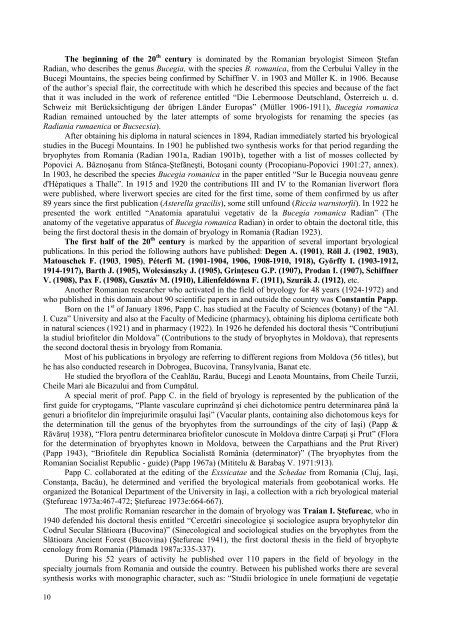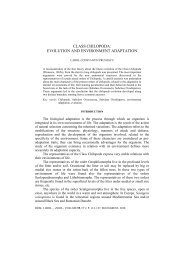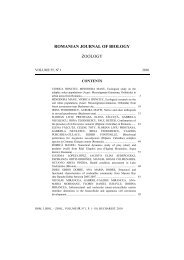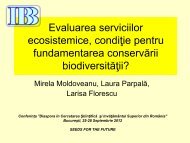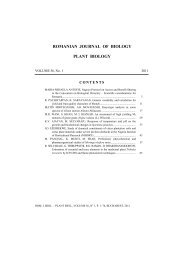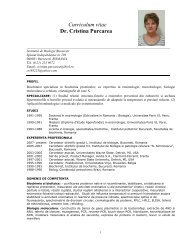The Hornwort and Liverwort Atlas of Romania
The Hornwort and Liverwort Atlas of Romania
The Hornwort and Liverwort Atlas of Romania
You also want an ePaper? Increase the reach of your titles
YUMPU automatically turns print PDFs into web optimized ePapers that Google loves.
<strong>The</strong> beginning <strong>of</strong> the 20 th century is dominated by the <strong>Romania</strong>n bryologist Simeon ŞtefanRadian, who describes the genus Bucegia, with the species B. romanica, from the Cerbului Valley in theBucegi Mountains, the species being confirmed by Schiffner V. in 1903 <strong>and</strong> Müller K. in 1906. Because<strong>of</strong> the author’s special flair, the correctitude with which he described this species <strong>and</strong> because <strong>of</strong> the factthat it was included in the work <strong>of</strong> reference entitled “Die Lebermoose Deutschl<strong>and</strong>, Österreich u. d.Schweiz mit Berücksichtigung der übrigen Länder Europas” (Müller 1906-1911), Bucegia romanicaRadian remained untouched by the later attempts <strong>of</strong> some bryologists for renaming the species (asRadiania rumaenica or Bucsecsia).After obtaining his diploma in natural sciences in 1894, Radian immediately started his bryologicalstudies in the Bucegi Mountains. In 1901 he published two synthesis works for that period regarding thebryophytes from <strong>Romania</strong> (Radian 1901a, Radian 1901b), together with a list <strong>of</strong> mosses collected byPopovici A. Bâznoşanu from Stânca-Ştefăneşti, Botoşani county (Procopianu-Popovici 1901:27, annex).In 1903, he described the species Bucegia romanica in the paper entitled “Sur le Bucegia nouveau genred'Hépatiques a Thalle”. In 1915 <strong>and</strong> 1920 the contributions III <strong>and</strong> IV to the <strong>Romania</strong>n liverwort florawere published, where liverwort species are cited for the first time, some <strong>of</strong> them confirmed by us after89 years since the first publication (Asterella gracilis), some still unfound (Riccia warnstorfii). In 1922 hepresented the work entitled “Anatomia aparatului vegetativ de la Bucegia romanica Radian” (<strong>The</strong>anatomy <strong>of</strong> the vegetative apparatus <strong>of</strong> Bucegia romanica Radian) in order to obtain the doctoral title, thisbeing the first doctoral thesis in the domain <strong>of</strong> bryology in <strong>Romania</strong> (Radian 1923).<strong>The</strong> first half <strong>of</strong> the 20 th century is marked by the apparition <strong>of</strong> several important bryologicalpublications. In this period the following authors have published: Degen A. (1901), Röll J. (1902, 1903),Matouschek F. (1903, 1905), Péterfi M. (1901-1904, 1906, 1908-1910, 1918), Györffy I. (1903-1912,1914-1917), Barth J. (1905), Wolcsánszky J. (1905), Grinţescu G.P. (1907), Prodan I. (1907), SchiffnerV. (1908), Pax F. (1908), Gusztáv M. (1910), Lilienfeldówna F. (1911), Szurák J. (1912), etc.Another <strong>Romania</strong>n researcher who activated in the field <strong>of</strong> bryology for 48 years (1924-1972) <strong>and</strong>who published in this domain about 90 scientific papers in <strong>and</strong> outside the country was Constantin Papp.Born on the 1 st <strong>of</strong> January 1896, Papp C. has studied at the Faculty <strong>of</strong> Sciences (botany) <strong>of</strong> the “Al.I. Cuza” University <strong>and</strong> also at the Faculty <strong>of</strong> Medicine (pharmacy), obtaining his diploma certificate bothin natural sciences (1921) <strong>and</strong> in pharmacy (1922). In 1926 he defended his doctoral thesis “Contribuţiunila studiul bri<strong>of</strong>itelor din Moldova” (Contributions to the study <strong>of</strong> bryophytes in Moldova), that representsthe second doctoral thesis in bryology from <strong>Romania</strong>.Most <strong>of</strong> his publications in bryology are referring to different regions from Moldova (56 titles), buthe has also conducted research in Dobrogea, Bucovina, Transylvania, Banat etc.He studied the bry<strong>of</strong>lora <strong>of</strong> the Ceahlău, Rarău, Bucegi <strong>and</strong> Leaota Mountains, from Cheile Turzii,Cheile Mari ale Bicazului <strong>and</strong> from Cumpătul.A special merit <strong>of</strong> pr<strong>of</strong>. Papp C. in the field <strong>of</strong> bryology is represented by the publication <strong>of</strong> thefirst guide for cryptogams, “Plante vasculare cuprinzând şi chei dichotomice pentru determinarea până lagenuri a bri<strong>of</strong>itelor din împrejurimile oraşului Iaşi” (Vacular plants, containing also dichotomous keys forthe determination till the genus <strong>of</strong> the bryophytes from the surroundings <strong>of</strong> the city <strong>of</strong> Iaşi) (Papp &Răvăruţ 1938), “Flora pentru determinarea bri<strong>of</strong>itelor cunoscute în Moldova dintre Carpaţi şi Prut” (Florafor the determination <strong>of</strong> bryophytes known in Moldova, between the Carpathians <strong>and</strong> the Prut River)(Papp 1943), “Bri<strong>of</strong>itele din Republica Socialistă România (determinator)” (<strong>The</strong> bryophytes from the<strong>Romania</strong>n Socialist Republic - guide) (Papp 1967a) (Mititelu & Barabaş V. 1971:913).Papp C. collaborated at the editing <strong>of</strong> the Exssicatae <strong>and</strong> the Schedae from <strong>Romania</strong> (Cluj, Iaşi,Constanţa, Bacău), he determined <strong>and</strong> verified the bryological materials from geobotanical works. Heorganized the Botanical Department <strong>of</strong> the University in Iaşi, a collection with a rich bryological material(Ştefureac 1973a:467-472; Ştefureac 1973e:664-667).<strong>The</strong> most prolific <strong>Romania</strong>n researcher in the domain <strong>of</strong> bryology was Traian I. Ştefureac, who in1940 defended his doctoral thesis entitled “Cercetări sinecologice şi sociologice asupra bryophytelor dinCodrul Secular Slătioara (Bucovina)” (Sinecological <strong>and</strong> sociological studies on the bryophytes from theSlătioara Ancient Forest (Bucovina) (Ştefureac 1941), the first doctoral thesis in the field <strong>of</strong> bryophytecenology from <strong>Romania</strong> (Plămadă 1987a:335-337).During his 52 years <strong>of</strong> activity he published over 110 papers in the field <strong>of</strong> bryology in thespecialty journals from <strong>Romania</strong> <strong>and</strong> outside the country. Between his published works there are severalsynthesis works with monographic character, such as: “Studii briologice în unele formaţiuni de vegetaţie10


